423a90af92d97e134561c83fca8f35b7.ppt
- Количество слайдов: 167

Unit 2 Population

Population Demography Spatial Distribution and Movement • Where are they? • Where are they going?

Population Scale • • of inquiry Global International National Local

Population Global Trends • Where are they growing fastest / slowest? • Identify trouble areas

Population Fastest Population Growth = Poorest Regions • Asia • Africa

Population Numbers • Intelligent Inquiries Population Equations • Global Population Accounting Equation Total global population • Sub global Population Accounting Equation Total Population of a Region

Population Equations • Global Population Accounting Equation Original Population + Births – Deaths • Sub global Population Accounting Equation Original Population + Births – Deaths + Immigration – Emigration Immigration – move in Emigration – move out

Population Distribution • Where are people? Population

Population Distribution • Environmental factors Too Cold Too Wet Too High Too Dry


Population Distribution 75 % on 5 % • Specific Regions • Hospitable Environment


Population Distribution Ecumene • Area that holds a permanent settlement

Expansion of the Ecumene 5000 B. C. –A. D. 1900 Fig. 2 -3: The ecumene, or the portion of the Earth with permanent human settlement, has expanded to cover most of the world’s land area.

Population Density • 3 Types Arithmetic Physiological Agricultural

Population Density Arithmetic • Total # of people / Total Land Area What does this not tell us? • Population Concentration

Population Density Physiological • Total # of people / Total Farmland How might this be helpful?

Population Density Agricultural • Total # of farmers per unit of arable land What different information might this give us?

Population Carrying Capacity • How many an area can support Factors • Wealth • Technology • Climate

Population Carrying Capacity Overpopulation • When a country outgrows it’s carrying capacity • Carrying capacity can be increased Improved technology Better use of land, etc

Population Measuring Population and Population Growth CBR CDR IMR Life Expectancy Fecundity GFR TFR

Population Growth CDR • Crude Death Rate # of Deaths per 1, 000 ppl per year CBR • Crude Birth Rate # of live births per 1, 000 ppl per year

Population Growth IMR • Infant Mortality Rate # of infant deaths per 1, 000 live births Must live 1 year


Population Growth Life Expectancy • Average lifespan Fecundity • Years a woman is able to conceive and bear children • 15 to 45


Population Growth GFR • General Fertility Rate Number of births per 1, 000 women in the fecund years TFR • Total Fertility Rate Predicted children a women will have during the fecund years




Population Growth Replacement Fertility • TFR = 2. 1 • 0 Population Growth

Population Growth RNI • Rate of Natural Increase • CBR – CDR / 10 • Does not figure migration stats

Unit 2 Population

Unit 2 Population

Population Pyramids • Evaluate a country’s population – Bar Graph – Age Group (Cohorts) • 5 years – Gender • Males on Left • Females on Right • Predict future population growth – Evaluate country’s future population position

http: //www. cdli. ca

Population Pyramids Graying Population • More old than young Problems • Who takes care of old? • Who pays for old? • Who will work?

Population Pyramids in U. S. Cities Fig. 2 -16: Population pyramids can vary greatly, with different fertility rates (Laredo vs. Honolulu), or among military bases (Unalaska), college towns (Lawrence), and retirement communities (Naples).

http: //www. cdli. ca

http: //www. nationmaster. com


Population Pyramid Dependency Ratio • Help to analyze work force / age distribution • 15 – 64 Independent • 15>x>64 Dependent

Population Pyramid Dependency Ratio • Too High = problem • Too many dependents = strain on society Strain on social services Fewer workers available for each dependent • General problems MDC’s – Too many old LDC’s – Too many young Especially parts of Africa that have been hits by AIDS

Unit 2 Population

Unit 2 Population

Population Through Time Beginning until 1750 • Modest population growth • 700 million in 1750 Wars, disease, draught, famine High birth and death • Current 6. 8 billion


Population Through Time Ages of Population Growth • 1 st Agricultural Revolution • Domestication of Animals / Crops Move from hunter gatherer -> farmer

Population Through Time 1 st Agricultural Revolution • More food = more people

Population Through Time Industrial Revolution • Use of technology 2 nd Agricultural Revolution • Improved farming technology • Improved fertilizer • Improved food storage

Population Through Time • Move toward cities – Technology creates new jobs • Other Agricultural Revolutions – Green Revolution – Bio Revolution • Medical Revolution – Spread of Medical technologies to poor countries


Demographic Transition Model Predicts changes in births, deaths, rates of natural increase • In the development of countries Use CBR, CDR, and Total Population

Demographic Transition Model 4 • • Stages Low Growth High Growth Moderate Growth Low Growth


Demographic Transition Model Stage • • 1 Low Growth High CBR and CDR = Low RNI Subsistence Farming Not industrialized


DTM Stage 2 • High Growth • Declining CDR Improved Technology / Improving Conditions • CBR stays similar • Causes High RNI


DTM Stage 3 • Moderate Growth • Declining CBR Lifestyle Changes Move to cities Smaller Families Women have more “options”


DTM Stage 4 • Low Growth CBR and CDR meet Low levels Low RNI Modern Countries Modern Technologies Low to Zero Population Growth


DTM Stage 5 • Negative Population Growth • CBR declines below CDR • Graying Populations


Unit 2 Population

Unit 2 Population

Epidemiologic Transition Model Correlates with the DTM • Causes of death in each Stage

ETM 4 Stages • Stage 1 Poor sanitary conditions Dysentery, Black Plague, Ebola • Stage 2 Overcrowding Cholera, Flu Highly communicable • Stage 3 & 4 Elderly

ETM Stage 5 • Reemerging Disease Avian Flu, MRSA

Population Pyramids & The DTM Basic pyramid shapes correlate to the DTM Represent population growth / future population growth We can guess what stage of the DTM based on the basic pyramid shape • Can also correlate to levels of development

Population Pyramids & The DTM Basic Shape 1 • DTM Stage 2 • Regular Pyramid High Growth Wide Base

Population Pyramids & The DTM Basic Shape 2 • DTM Stage 3 • Extended Pentagon Moderate Growth Even base and sides

Population Pyramids & The DTM Basic Shape 3 • DTM Stage 4 • Column Slow to no growth Even sides

Population Pyramids & The DTM Basic Shape 4 • DTM Stage 5 • Reduced Pentagon Negative Growth Sides are moving in Indicates falling birth rates

Population Pyramids & The DTM Basic Shape 3 • DTM Stage 3

Unit 2 Population

Population Policies Government / State Policies • Try to solve problems Overpopulation Underpopulation • Increase status of a state For the benefit of the state nationalism Pronatalist Antinatalist

Population Policies Pronatalist • Produce larger families • Larger population Antinatalist • Curb population growth

Population Policies Pronatalist • Historical Achieve state goal Conquer territory Meet economic objective Nationalism / Status of the state • Recent Curb population decline Need to sustain economy / viability of the government Maintain native population Not be overtaken by foreign cultures / populations

Population Policies Pronatalist • Policies Tax incentives Tax credit Tax deduction Cash rewards / prizes Pay for child care / day care

Population Policies Antinatialist • Over population Cannot sustain population growth Cannot meet the needs of the population and future population Food, Economics Controlled and planned economies

Population Policies Antinatalist • Policies 1 Child Policy Restrictions on family Where they can live, work, etc

U. S. S. R. - pro-natalist Starting on July 8, 1944 the government of the U. S. S. R. began awarding medals to women in order to encourage a high fertility rate.

Why did the government believe there was a need for a pro-natalist policy at this time ?

3 main categories of medals were presented • Motherhood Medals • Order of the Glory of Motherhood or Order of Maternal Glory • Order of Mother Heroine

Motherhood Medal 5 children 2 nd Class 8, 000 awarded

Order Mother Heroine 10 children 200, 000 awarded

Motherhood Medal 6 children 1 st Class 4, 000 awarded

Order of Maternal Glory 7 children 3 rd Class 2, 000 awarded

Order of Maternal Glory 8 children 2 nd Class 1, 000 awarded

Order of Maternal Glory 9 children 1 st Class 500, 000 awarded

Population Theories Thomas Malthus Karl Marx Ester Boserup Neo Malthusians

Population Theories Thomas Malthus • The earth has a natural limit • Large populations strain natural resources • Earth creates “natural checks” War, famine, disease, natural disaster, etc

Thomas Malthus Positive Checks • Violent Negative (Preventative) Checks • Birth Control • Celibacy

Thomas Malthus

Thomas Malthus Critics Say • Improved Technology • Allows more people In less space



Karl Marx Unequal distribution of wealth • Middle and Upper Class • Upper Class Exploits Middle Class

Ester Boserup Larger Populations • Forces innovation • Technological Development • More people = more opportunities for problem solvers Human Capital

Neo-Malthusians Similar to Malthus • Only certain parts of the world need to slow growth • Characteristic of the region • Provide more room for contraceptions

Unit 2 Population

Unit 2 Population

Populations Movement Increased migration • Improved technology / transportation • Increased wealth Impact • Culture • Economics • Environment


Population Movement Migration • Permanently move from home region • Cross to another administrative boundary

Population Movement Immigration • Move to a place Emigration • Move out of a place

Population Movement Net In-Migration • More immigrants than emigrants Net Out-Migration • More emigrants than immigrants

Population Movement Migration Streams • Where? • Why? Counter Stream • Move against the current in migration

Population Movement Push Factor • Why they leave Pull Factor • Why they come

Population Movement Migration Selectivity • How likely is someone to migrate • Based on: Personal, social, economic

Population Movement Age • 18 to 30

Population Movement Brain Drain • Worry of Gov’ts More Education • More likely to leave Brain Drain • Most educated leave

Population Movement Brain Drain • Keep workers from leaving HOPE Scholarship

Population Movement Two types of Migration • Voluntary • Involuntary / Forced Refugees • Involuntary Migrants • Flee persecution or abuse

Population Movement Refugees • International Flee to another • Intranational Move within the country

Refugees: Sources and destinations Fig. 3 -1: Major source and destination areas of both international and internal refugees.

Population Movement Internally • • Displaced Persons Refugees who do not move to a new country Face all the hardships of a refugee Are not given refugee status by the UN International support and aid is not required

Forced Migration around the World Sub-Saharan Africa Middle East (SW Asia) Europe South Asia

Sub Saharan Africa Conflict in Rwanda and Congo • Tribal and Ethnic Conflict Darfur in Sudan • Animist and Muslims

Sub Saharan Africa Zaire, Tanzania, Uganda, Liberia, Sierra Leone, Angola, and Burundi • War related relocation

Mid East / SW Asia Palestinians • Creation of Israel Kurds in Iraq • Under Saddam Hussein Afghans under the Soviets

Europe Yugoslavia • 7 million refugees fled to Europe

SE Asia Vietnam War • Displacement of Vietnamese Cambodia • Khmer Rouge • 300, 000 Refugees Myanmar / Burma

South Asia Sri Lanka • 1 million displaced by Sinhalese Government

Movement of People Generally • Moving from: Asia, Africa, Latin America • Moving to: America, Oceania, Europe

External Migration Post World War II Jewish East immigrants to Israel German immigrants • To West Germany • Soviet Control / Communism

External Migration Asian immigrants • To the US • From Philippines, Vietnam, and India North Africa and Turkish • To Europe • Germany and England

Unit 2 Population

Unit 2 Population

3 Migration Waves to the US Colonial Era 19 th and 20 th Century Late 20 th Century

Colonial Era 1607 to 1776 From Europe and Africa Europeans • Religious persecution • New life Africans • Slave trade

Colonial Era Immigrants came to the East Coast

19 th and 20 th Century 1800’s & 1900’s Ireland Post and Germany Civil War • Russia and Hungary

Late 20 th Century 1970 s and 1980 s • Asia 1980 s on • Latin America

US Immigration Policy Unrestricted Quota 1924 Act of 1921 / National Origin Act of • Sets limits • Non-Western Europeans • Based on total number of immigrants 2% 1910 Census

US Immigration Policy 1968 • Country quotas replaced • Hemisphere Quota East – 170, 000 West – 120, 000

Migration to U. S. , by region of origin Fig. 3 -4: Most migrants to the U. S. were from Europe until the 1960 s. Since then, Latin America and Asia have become the main sources of immigrants.

US Immigration Policy 1978 • Global Quota • 290, 000 • 20, 000

US Immigration Policy Current • 620, 000 • 7% Policy

Unit 2 Population

Unit 2 Population

Internal Migration Movement Two within a country Types • Interregional • Intraregional

Internal Migration Industry • Intraregional Rural to Urban to Suburban

Internal Migration Crowded Cities • Counterstream Counterurbanization • City to rural • New transportation / technology / jobs

Internal Migration General US Migration • Southward and Westward Baby boomers • Move south • Better weather • Improved Racial Tensions Available Jobs

Interregional Migration in the U. S. Fig. 3 -13: Average annual migrations between regions in the U. S. in 1995 and in 2000.
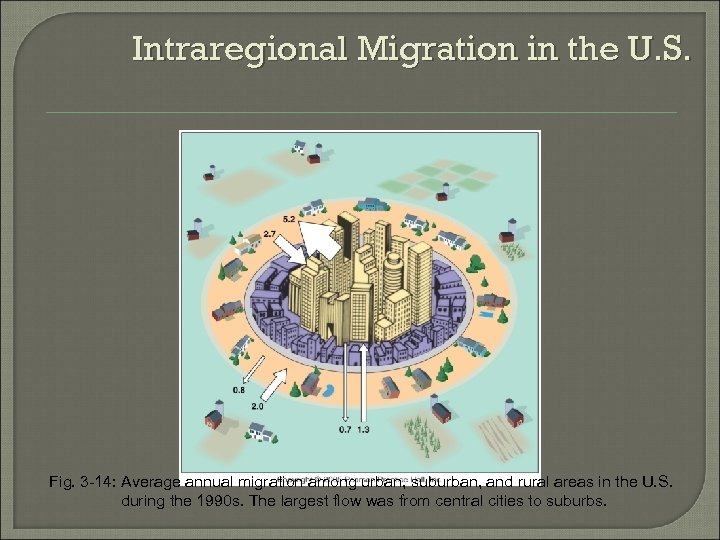
Intraregional Migration in the U. S. Fig. 3 -14: Average annual migration among urban, suburban, and rural areas in the U. S. during the 1990 s. The largest flow was from central cities to suburbs.

Migration Models and Theories Gravity Model • Interaction and movement between places More people = • More immigrants Distance is an immigration factor
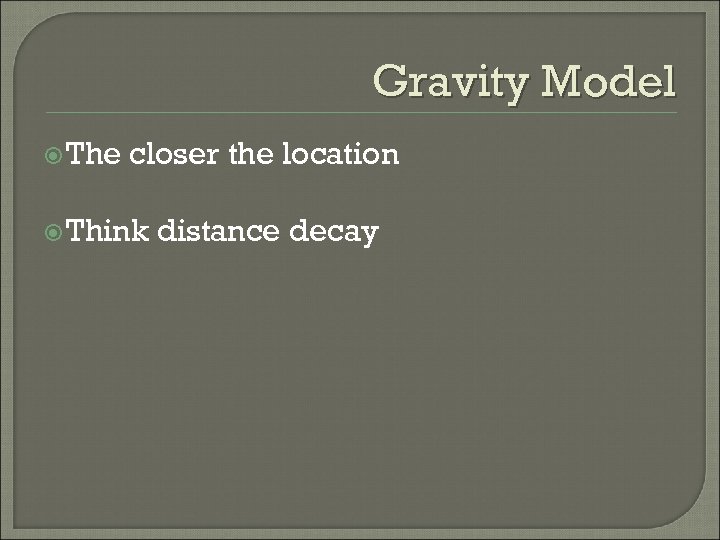
Gravity Model The closer the location Think distance decay

Gravity Model Does not account for… Selectivity Factors (Education Level, Age, Job Opportunities) 2. Unpredictable Human Behaviors 1.
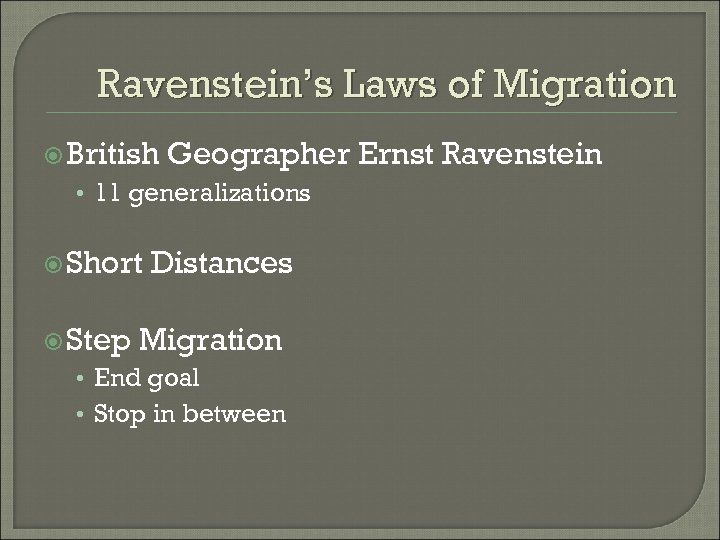
Ravenstein’s Laws of Migration British Geographer Ernst Ravenstein • 11 generalizations Short Step Distances Migration • End goal • Stop in between

Ravenstein’s Laws Intervening Obstacles • Keeps one from completing migration 1. 2. 3. 4.
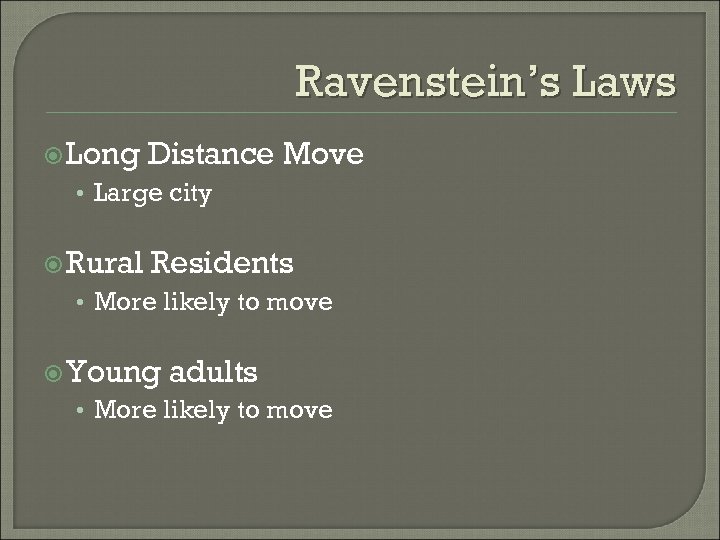
Ravenstein’s Laws Long Distance Move • Large city Rural Residents • More likely to move Young adults • More likely to move

Ravenstein’s Laws Migration creates counterstream
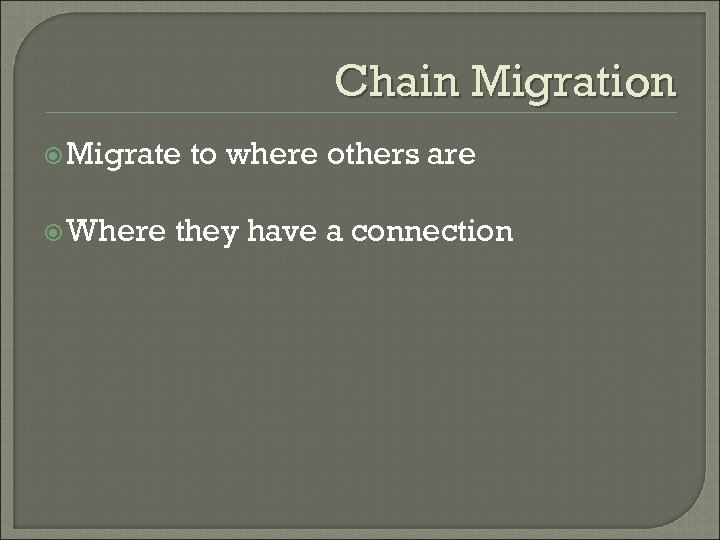
Chain Migration Migrate Where to where others are they have a connection
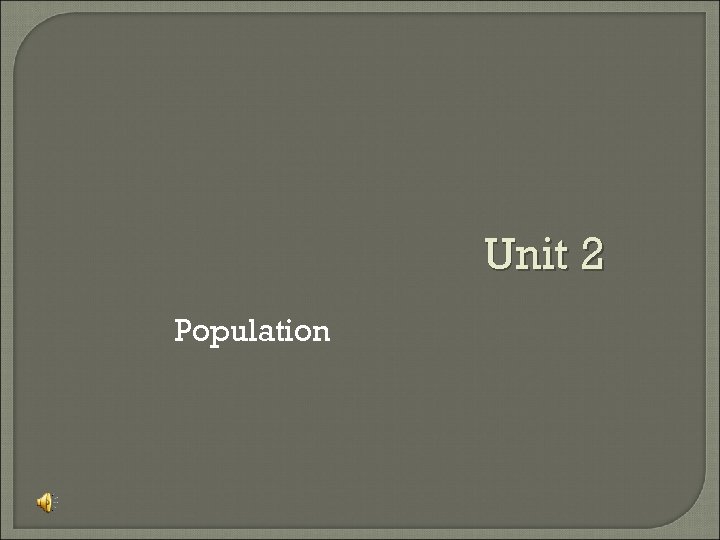
Unit 2 Population
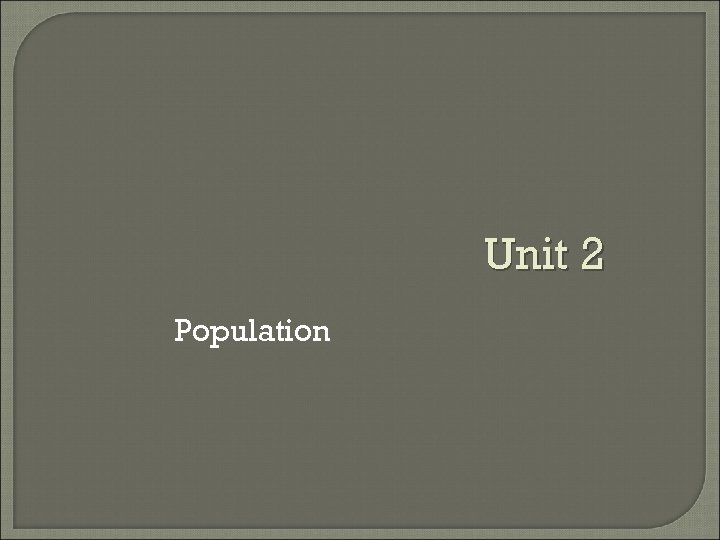
Unit 2 Population
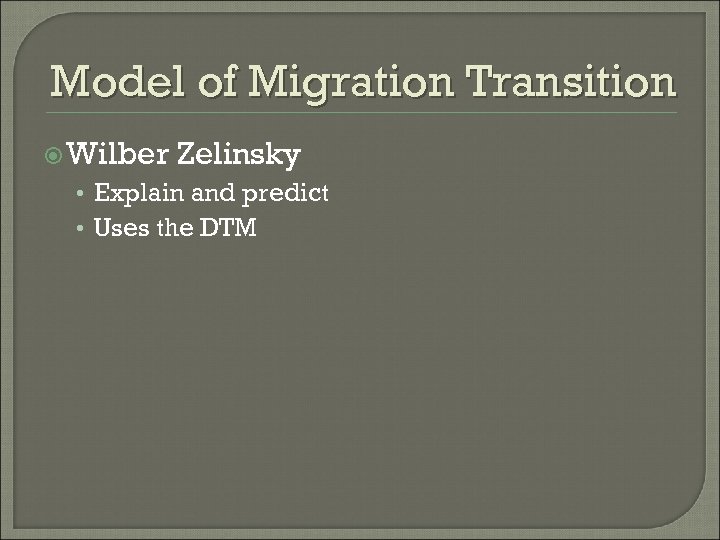
Model of Migration Transition Wilber Zelinsky • Explain and predict • Uses the DTM
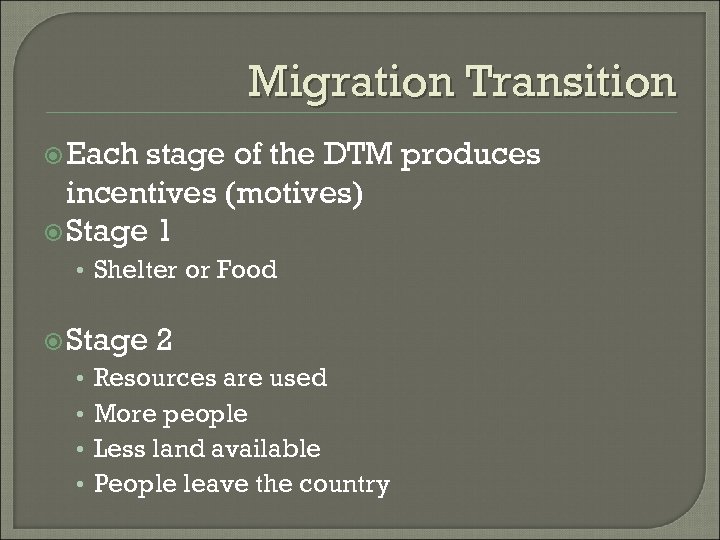
Migration Transition Each stage of the DTM produces incentives (motives) Stage 1 • Shelter or Food Stage • • 2 Resources are used More people Less land available People leave the country
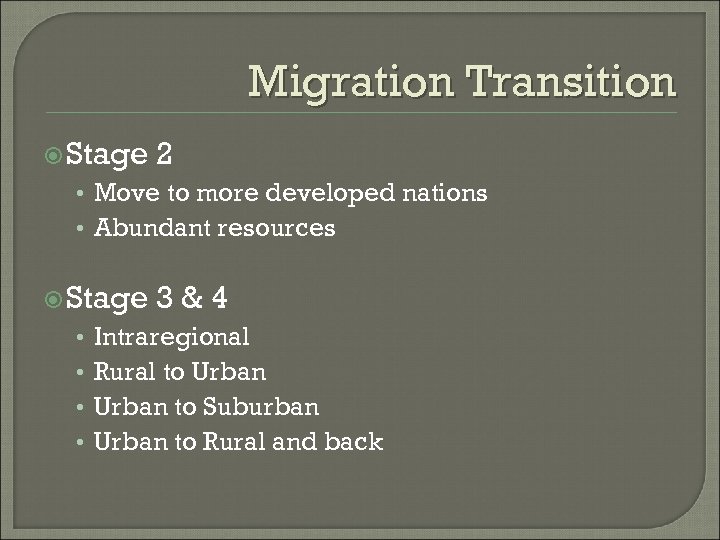
Migration Transition Stage 2 • Move to more developed nations • Abundant resources Stage • • 3&4 Intraregional Rural to Urban to Suburban Urban to Rural and back
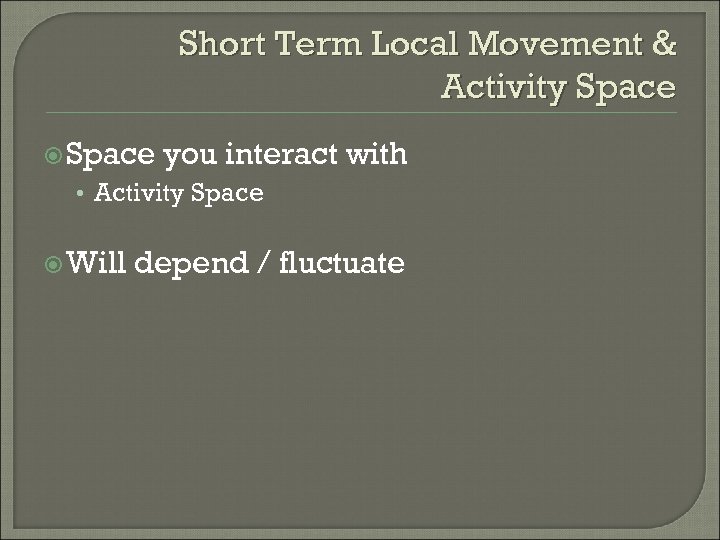
Short Term Local Movement & Activity Space you interact with • Activity Space Will depend / fluctuate
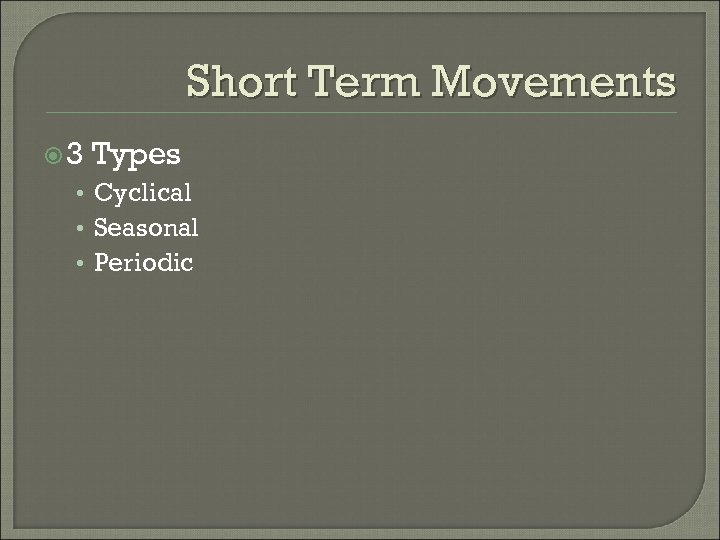
Short Term Movements 3 Types • Cyclical • Seasonal • Periodic
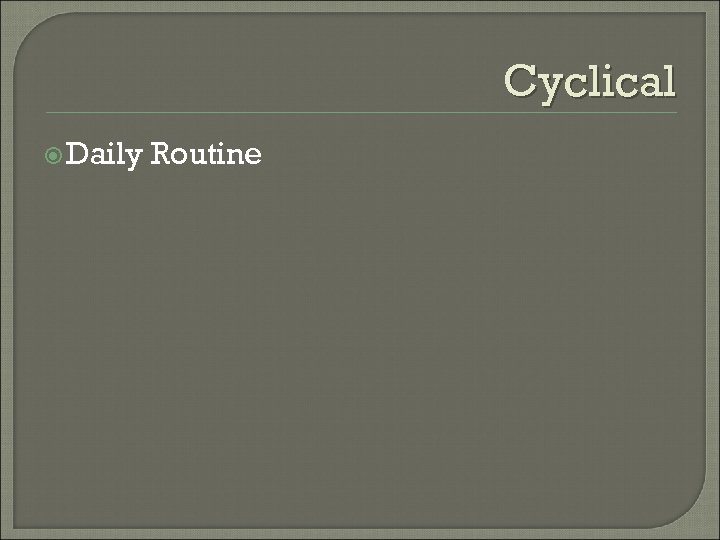
Cyclical Daily Routine
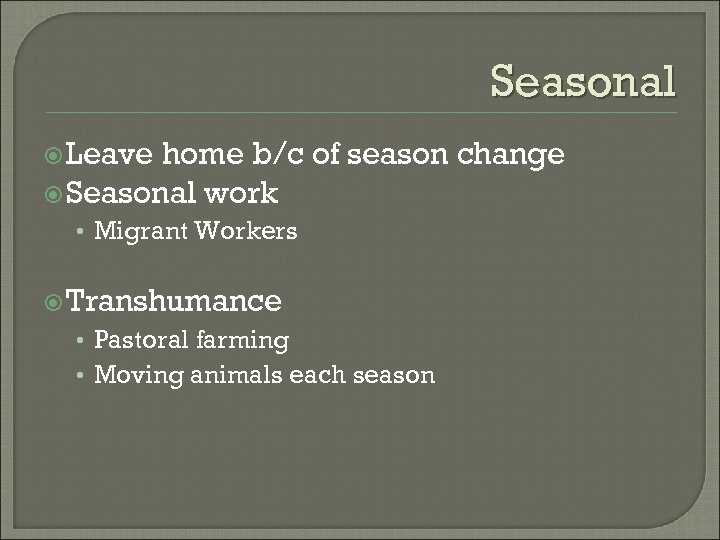
Seasonal Leave home b/c of season change Seasonal work • Migrant Workers Transhumance • Pastoral farming • Moving animals each season
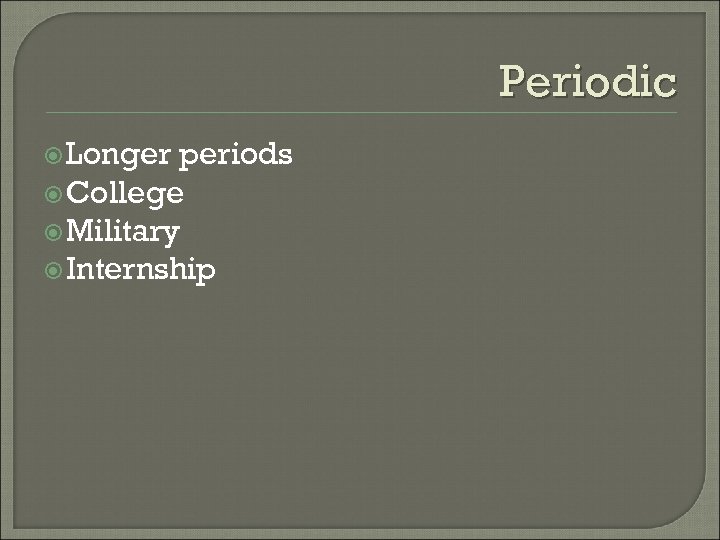
Periodic Longer periods College Military Internship
423a90af92d97e134561c83fca8f35b7.ppt